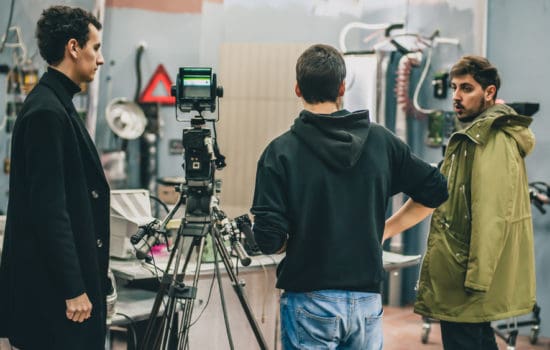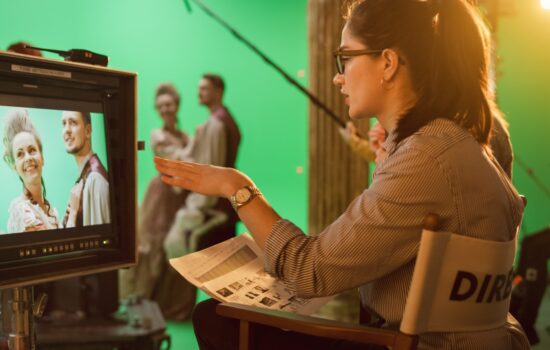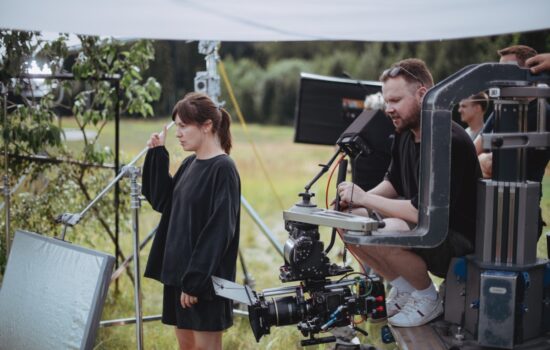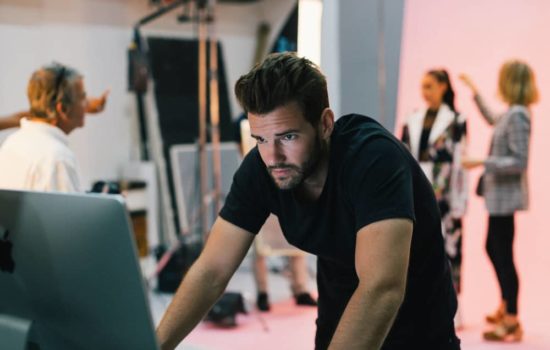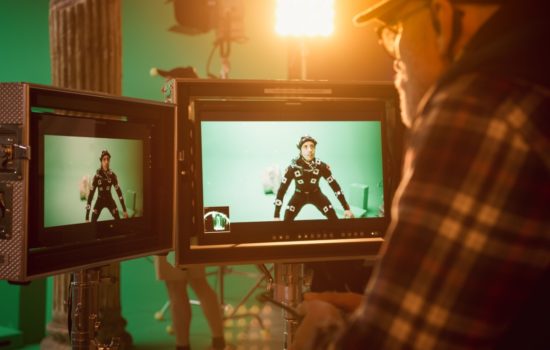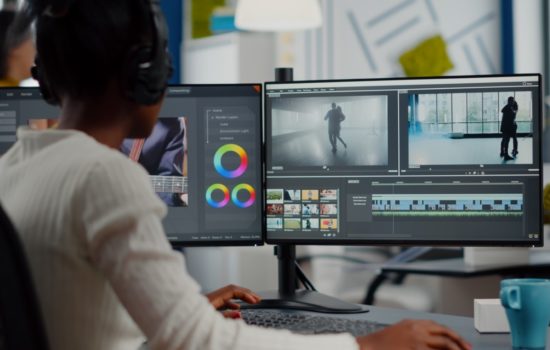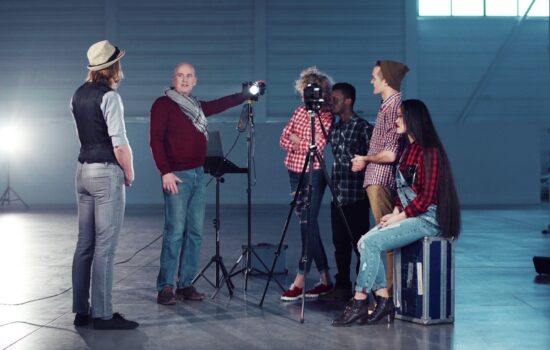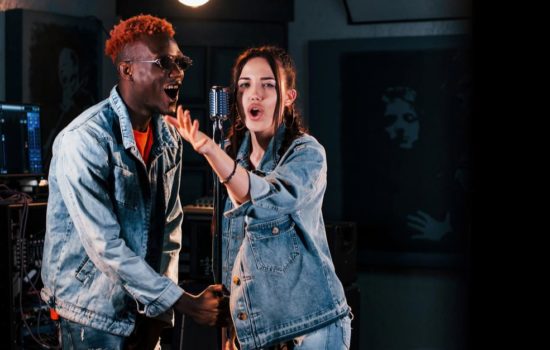Colorist
Career Overview
What exactly does the role of a Colorist entail? We’re breaking down this position that is equal parts creative and technical in the world of post-production.
Alternate Titles
Digital Colorist, Post Digital Imaging Technician, Grader
Avg. Salary
$40,097 – $58,152
Salary Range
$40,097 – $58,152

How To Become a Colorist
People also ask
Career Description
The Colorist digitally processes the final images of a project and typically works on a variety of media ranging from commercials to short films to features. At times the job of a Colorist is to correct poorly shot footage that may suffer from issues such as overexposure or poor lighting. This is called color correction. Other times, they deliberately alter otherwise normal footage to heighten elements like contrast, hue, or brightness to achieve a specific visual style. This is called color grading.
New to the world of color grading? This video offers a comprehensive breakdown of this essential filmmaking specialty.
Colorists generally work on multiple projects at any given time with their primary point of contact being the Director or Cinematographer on a project. They might at times have the Director or Cinematographer meet them in person to discuss the project and take notes. Other times, they can communicate via email or another remote method.
The amount of time that a Colorist will devote to a project depends on several factors, including the scope of it and attention required for its coloring needs.
To learn more about working as a Colorist, we spoke to:
- Peter Doyle (His Three Daughters, Creed III, Spirited)
- Tyler Roth (Take Care of Maya, Daisy Jones & The Six, The Terminal List)
What does a Colorist do?
A Colorist, using dedicated software, will match shots from varying cameras, lenses, lights, angles, time of day, locations & weather into a consistent sequence.
The process is typically credited as Color Grade, Finishing, or DI and the end result of a color grade session is a final grade, which will then need an additional conversion to format the final grade for a specific display format. EG Streaming in HDR10, Theatrical in DCI XYZ, QT’s laptop reviews in rec 709, each requiring its own grade, typically called a trim pass.
The grading and matching of shots is both a technical and creative process and draws from color science, color theory, and film language.
Whilst the process of matching and technically making the shots work with each other is considered Match Grading, the final color or style of a sequence is typically called a Look or grade. It is the creation of Looks that work across a sequence and the complete film that is considered a Colorist’s greatest attribute.
Dailies, music videos, commercials, and long-form are considered the four main areas of specialization within color grading. The main consideration is if a look that may look great in a music video does not overpower the story and Actors in a long-form.
Typical grading scenarios would be:
- A sequence has been shot across several days with varying weather; the script calls for the sequence to play as a single moment at night.
- A sequence has been shot with a modern camera; the script calls for the film to be set in the 1900s.
- A sequence has been shot documentary style in a suburb; the script calls for the mode to evoke American gothic.
Knowing how to process the imagery and defining what the look should be to achieve the brief is, ultimately the Colorist’s greatest skill.
Usually, the Colorist begins by setting the overall look for each of the scenes using a wide shot. Once the client agrees on an image the Colorist moves on to match each of the other camera setups for that section.
After a first pass has been made, everyone reviews the work in its entirety before going back to finesse the fine details. This cycle repeats for every setup on every project until it’s time to go home.
Salary
Freelance Colorists set their own hourly, day, or per-project rate. However, Colorists can also have salaried positions in post-production houses that do color correction and color grading work as vendors.
Whether a freelancer or salaried employee, Colorists who are part of the Motion Picture Editors Guild have scale rates set for them.
If you’re a novice Colorist, check out this video to learn more about avoiding a common beginner’s mistake.
A freelance Colorist who sets their own rates can charge a day fee as high as $700 to $1,000.
That being said, what a Colorist makes as an annual salary can fluctuate greatly from year to year based on multiple factors. These factors include the number of projects a Colorist takes on in a given year, the workload required for each project, and the overall budget allotted for color correction and color grading services.
According to Salary.com, the current average annual salary for a Colorist is $48,123.
How much does a film/TV Colorist make?
Rates for freelance Colorists and those on staff at a post-production facility will vary. Rates will also increase as Colorists gain experience.
The day rate for Colorists usually spans from $700 to $1,000.
How much do you pay a Colorist?
If you’re in the market for a Colorist, it’s important to understand that this professional provides a vital contribution towards the filmmaking process. Meaning, they may charge a fee of several hundred dollars a day or more for their services. The cost of hiring a Colorist comes down to multiple factors, including their experience, the scope of the project, and amount of work required to achieve your desired visuals for the project.
Hey, what do you think about trying our new Film Career HelperFilm Career Helper really quick? It’s totally free and could help get your career moving fast! Give it a try. It’s totally free and you have nothing to lose.
Career Outlook
The demand for a great Colorist can be high, as color correction and color grading are common necessities on projects. But it’s also a career that requires a fair amount of time juggling and client hustling.
Roth states that he works “70% commercial, 25% features, and 5% short films, but the ratio is different for each Colorist.”
When it comes to his commercial work, Roth has your average 9am to 6pm, Monday through Friday schedule. During that timeframe, he’ll usually work on a 30-second spot for two to three hours, which typically translates to three to five projects a day.
There are no shortcuts to becoming a great Colorist, but this video explains some hacks to speed up the process.
But then there’s the time he puts into his film work.
It’s not unusual for a Colorist to work evenings and weekends. For Roth, it’s when he devotes his time to features and short films.
Depending on how experienced a Colorist is, they might have Assistants to help with projects, as Roth does. One Assistant works alongside him from 9am to 5pm during the week. Another Assistant takes the night shift from 4pm to 12am to prep their various projects and handle exports.
While the workflow might vary throughout the week depending on the client load, Roth notes that it’s always busy.
But if a Colorist can demonstrate to clients that they can take their notes and apply them as needed, as well as deliver the project on time, they can build a notable reputation throughout the course of their career that results in consistent work.
How long does it take to become a Colorist?
That’s a very difficult thing to define.
You could say, as soon as you think you are a Colorist, you’re not.
Each project is so different, you really are rebuilding your skills and references every time. It’s actually refining that process as a skill set that will place you in demand.
Every Director and DP wants to create something unique; to have a partner at the color controls who emanates empathy and excitement for the individual project is paramount.
However, experience, understanding the buttons, and knowing when you might be getting into trouble are invaluable. So, ideally, you would have at least maybe six films in the format you’re delivering to feel confident you have everything covered.
Be aware it can take multiple internships before landing a job that can launch a career. Due to the number of applicants, it can be difficult to break in so even if the opportunity is getting someone else’s coffee, take it.
What does it mean when someone is a Colorist?
A Colorist is a pivotal part of the post-production team on a film or other form of visual entertainment. This person makes alterations to the look of the footage to either correct errors during the shooting of it or to intentionally alter the footage for a particular stylistic effect.
Career Path
There’s no one path that leads to becoming a Colorist.
Film school can be a great starting point for understanding what those elements of filmmaking entail and how coloring incorporates both via color theory. Whether or not an aspiring Colorist goes to film school, they will certainly need plenty of real-world experience before they reach a level where they are handling projects on their own.
That means entering the entertainment industry as an Intern or Production Assistant. And if possible, getting work in a post-production house where they offer color correction and color grading services.
Filmmakers often note that they want their projects to look “more cinematic.” What does that mean and how can a Colorist achieve it? This video explains.
That means entering the entertainment industry as an intern or Production Assistant. And if possible, getting work in a post-production house where they offer color correction and color grading services.
While the extent of an Intern or PA’s responsibilities may be running errands and getting coffee, these experiences can be hugely important to their future career as a Colorist.
It’s in these positions that an aspiring Colorist can meet established professionals and learn what it takes to be great at this job, which includes technical, artistic, and communication skills.
Often during a stint as an Intern or Production Assistant, an aspiring Colorist will begin to learn how to work with the most common software used for color correction and color grading.
These programs include:
- Baselight
- Chromatic
- Cinema Grade
- Color Fixer Pro
- DaVinci Resolve
- Filmcovert Nitrate
- Final Cut Pro
- HitFilm Pro
- Lightworks
- Red Giant Colorista
- VEGAS Pro
With this baseline knowledge, they might then get promoted to a Coloring Assistant or Assistant Colorist. In these roles, it becomes the aspiring Colorist’s job to prep projects and render out completed work. They may also do basic computer maintenance and file repair.
Should someone in this position get bumped to a Junior Colorist, it’s at this stage that they’ve gained enough experience to start finding their own work.
It’s important to understand that to build these skillsets and client relationships, it might mean years of working pro bono or for a very low fee on projects. To help sell their skills and expertise, emerging Colorists should always have a 60-second reel ready to show their most impressive and/or recent work.
As they continue to develop their technical and artistic skills, it’s just as important for an aspiring Colorist to work on building relationships and having great communication skills that make clients want to come back to them for the next project.
While the turnaround for commercial work can be quick, films can take months or even years to reach completion. Because of this, Colorists must always be developing their professional network, as it may be a significant amount of time between projects for any single client.
With ample experience under their belt and advanced expertise, they then can jump into the role of Colorist. But even once someone gains that title, they can still expect to be continually reaching out to make and maintain the professional relationships that will translate into future work.
How do you become a Colorist?
The best way for someone fresh out of college to become a Colorist is to get a foot in the door at a coloring facility.
The entry-level position within a coloring company is to work as a Runner, doing whatever the company needs. It can include getting a lot of coffee. Whatever the task is it’s important to impress the higher-ups with attention to detail, organization, and client service skills.
Whatever job is available, grab it, whether it’s an Office Manager, Intern, or Runner position. Even if it’s not the facility where the aspiring Colorist ultimately wants to work they’ll acquire experience in workflows and day-to-day tasks.
Either start grading music videos and short films, learn by DIY.
Or…
Start in a post facility, as an Assistant or Runner, and learn by observation. The latter can be invaluable, as you’ll be working with varying Colorists’ timelines and learning the differing approaches.
Or…
Start as a Data Wrangler on a rushes show, then migrate across to a Dailies Colorist.
Can you be a professional Colorist?
Absolutely! It is within anyone’s reach to be a professional Colorist so long as they undergo the proper training for the job. This includes understanding the most popular software platforms that allow for coloring work to be done, as well as being able to take direction from filmmakers regarding what they want their final footage to look like and executing that vision for them.
Experience & Skills
The skillsets required to be a Colorist in demand fall into multiple categories.
For one, you need to understand the technical side of this career.
That means knowing your way around a computer, as well as learning about different file types and codecs. These skills will help you develop your knowledge of how color edits and computers interact. Keeping up with the technological developments of the equipment you use is likewise critical to a Colorist’s career.
Two, you must have an artistic sensibility that can help in guiding your color grading choices.
For instance, understanding that greater saturation might invoke a sense of heightened reality or that blue tones can indicate a feeling of sadness or isolation.
And three, you must be extremely comfortable taking notes from others in this industry (like Directors and Cinematographers) and be able to communicate with them.
Why does color even matter in film? This video provides a comprehensive overview of color theory and how it factors into the way audiences respond to the visuals of a movie.
There will likely be times when people in these positions struggle to explain exactly what they want, and it’s the Colorist’s job to decipher their feedback and make adjustments accordingly.
All of these skillsets considered, there’s a good reason why many aspiring Colorists first develop their craft in college. A solid background in understanding the filmmaking process–especially the cinematography and visual effects disciplines–can greatly help someone looking to enter this field.
Whether or not college is part of someone’s plan in learning these skills, they should always be studying films, television shows, and commercials to become more aware of the possible techniques used to create the images they see. Even veteran Colorists continually analyze what they watch to learn from other professionals in the business.
The most successful Colorists have this unique balance of technical, artistic, and communication skills.
But they’re also business savvy. Look at it from the client’s perspective. They’re paying for a costly room and the Colorist’s rate, so time is of the essence. Therefore, they need to believe they’ll receive a certain quality of work without any problems. For the Colorist, that means being able to work quickly and effectively to keep the client happy and hopefully have them return for future work.
What kind of skills does a Colorist need?
The best way to prepare for becoming a Colorist is to acquire technical savvy. The Colorist [him or herself] is a brand that needs to be personable, artistic and technically competent.
There are some specialized courses people can take but many aren’t that great. There are a lot of different ways to color. Much of it depends on personal style and workflow. If an aspiring Colorist can shadow a professional, get their hands on a system and practice, they can learn through experience, which is the best teacher overall.
Film history and understanding the language of filmmaking, focusing on the disciplines of editing and lighting is important. This is the only way you will be able to talk with your clients.
Understanding the Camera Department functions and the challenges a DP faces can help a lot. The most important skill is understanding light, to have a complete understanding of the what/how’s a DP creates their imagery. After all, you are their partner and collaborator.
And lastly empathy! You really need to read the room.
The color grade is the last stop before the Director and DP deliver the film. It’s a cruelly final process, the team have been dreaming, designing, and working to create their vision for months, typically years on a feature. It’s in the Colorist room they finally see the results come together with you bringing the final touches to finally release it.
It’s when Art becomes Product.
Education & Training
If a person aspires to be a Colorist, they likely have a general interest in movies and entertainment as well, which is another reason film school is such a popular choice among those seeking this career.
Depending on the program, they might even get early practice familiarizing themselves with the software needed to color, which they can then use on student films. College also offers the chance to better understand how coloring combines the worlds of cinematography and visual effects.
Some aspiring Colorists might also study general art and color theory while in school to better understand how color plays a role in telling a story and evoking specific emotions and reactions.
Watch in real time as Hollywood Colorist Chris Jacobson color grades the show Suits on DaVinci Resolve.
While in college or at the outset of their career, aspiring Colorists should look for every entry-level opportunity that presents itself such as an internship or PA role at a post-production house to start gaining that experience as soon as possible.
These types of jobs can provide a sense of how the post-production process works and where color correction and color grading fit into it. At the same time, it’s a great opportunity for aspiring Colorists to meet others who work in this specific niche of the industry and make the connections necessary to keep working their way up the career ladder.
Spending a few years in a post-production house or two can prove vital to getting the training necessary to become a successful Colorist. Once they move into the role of lead Colorist, they then can decide if they’d rather work on their own as a freelancer or stay with a company as part of a larger post-production facility.
Additional Resources
Roth notes, “It’s difficult to find good online forums or resources for coloring because many of them are run by inexperienced people fresh out of college. However, the Lowepost Colorist Community (run by Stig Olsen) is an amazing resource. It has some free content but there is also a section to pay for premium material. The best Colorists in the world submit project breakdowns and stills and discuss their work.”
He adds, “Check out YouTube for technical tutorials. It’s easy to find a myriad of videos on coloring software, color grading, using color space, and working with HDR footage. Online materials can be great but they aren’t a substitute for practice or experience.”
Additional online resources include the forum Lift Gamma Gain, Colorist Alexis Van Hurkman’s blog, and Premium Beat. Premium Beat is a general filmmaking resource, but it has key articles relating to the color grading process.
Remember, to find work as a Colorist, networking is key. Always stay in touch with your professional colleagues and find opportunities to meet Directors and Cinematographers who may one day be in a position to hire you.
Entertainment-specific sites such as Mandy.com and EntertainmentCareers.net are good resources for coloring gigs. You can search more broad resources like Indeed.com or SimplyHired.com for job openings as well.
FAQ
What is the single biggest suggestion you would give to someone wanting to get into this career?
“It’s important to find the right balance between taking free work to gain experience versus waiting for paid work. One effective method is to do work for free in exchange for referrals to other potential clients. It’s easy to become the freebie person.
“Colorists always need to be improving their brand, even from when they first start. It’s important for them to have a game plan for how free work will establish their reputation.”
What’s the #1 mistake people make when trying to get into this career?
“The biggest mistake for beginning Colorists is they want to take on every project for free without establishing a game plan to set themselves up as a professional. The right balance between paid work and giving discounts evolves over time.
“It’s important to think about it as early as possible to create a sustainable career. Many people don’t talk about or think of the business side of being a Colorist. It bites them in the long run.”
What is the question people should ask about this career but rarely do?
“What is the artistic intent behind an image?
“Most aspiring Colorists rarely ask about the artistic intent behind a coloring job and instead focus exclusively on the technical aspects. They think if they know how it was generated they can emulate it, which isn’t bad for becoming a technician, but won’t inspire them artistically.
“It can also make people believe that for something to be good it needs to be complicated. Great color grading is great color grading. It doesn’t need to be complicated. A beautiful image can be created with only four layers if it achieves the artistic goal.
What is one thing I should have asked which I didn’t?
“Why is business so important for Colorists?
“It’s the business aspects of being a Colorist that separates the top-tier professionals from everyone else. People rarely consider how learning business skills will help them land better jobs. They will be able to offer better discounts, create a more impressive demo reel and have a company behind them to take care of menial tasks.
“Developing a brand that can be sold isn’t easy. It takes time and effort but it also allows for larger jobs and the circumstances to do better work. The business of coloring is the secret of success that’s never talked about in any textbooks or forums.”
If you could describe in one word what makes you successful, what would it be?
“Collaborative! It’s easy to get stubborn, but at the end of the day, the Colorist is a vendor making other people’s dreams come true.”
Sources

Peter Doyle
From using custom software to color grade sequences of the The Matrix in the ’90s, to commissioning the first DI grading packages for The Lord of the Rings in the late ’90s, building a “pop up” DI facility for WB to grade the Harry Potter films in the ’00s, through to working with the Coen Bros. on their first digitally originated film, Peter has worked with Directors & DPs who have consistently pushed the boundaries of visual media.
Peter has worked with Visual Artists, including Alexander Sokurov, Shirin Neshat & Julian Schnabel, and has formed long-term collaborations with DPs such as Bruno Delbonnel, Seamus McGarvey and Philippe Rousselot, and such diverse Directors such as Tim Burton, Joe Wright, Guy Ritchie, Peter Jackson, and Alfonso Cuarón.
As a pioneer of new thinking, Peter helped transform traditional film lab chemical processes into bespoke digital methods that ensured greater creative choice and a color aesthetic that is no longer bound by the film process. He went on to collaborate with Andrew Lesnie on The Fellowship of the Ring, which won the first Oscar for Best Cinematography that used DI as a tool, and subsequently graded four of Bruno Delbonnel’s five Oscar nominations for Best Cinematography.
Peter is currently working with PostWorks NYC, contributing to the design of a new unified colour ecosystem that embraces the entire imaging design process and creative production pipeline, from rushes to control of VFX plates, final release, DCI, streaming, and physical deliverables.

Tyler Roth
Based at Company 3 Los Angeles. Available virtually through any Company 3 Virtual Outpost.
Tyler Roth specializes in stylized and unique looks for his many commercial, music video, and feature film clients. His reputation as a fast, creative, and technically-minded Colorist has brought him international acclaim and to be sought after by top brands such as Google, Modelo, Porsche, Vanity Fair, Dodge, Michelob Ultra, Adidas, and Cisco. Recent music videos include work for Dua Lipa, Tyler The Creator, Kelly Rowland, Maluma, Rita Ora, Hailee Steinfeld, and The Black Eyed Peas. He also was among the first to use the new Hybrid Log Gamma version of HDR to grade for the Pepsi-sponsored lead-in into the 2020 Super Bowl Halftime Show.
Roth’s film credits have seen world premieres and have garnered awards at Sundance, Cannes, SXSW, and other festivals. Particularly notable projects include the powerful Oscar-nominated documentary, Minding the Gap for director/DP Bing Liu; The Worker’s Cup (Sundance 2017, nominated for Grand Jury Award); and the cathartic We Are Columbine (winner of the 2018 Atlanta DocuFest Festival Prize). Narrative credits include the Hillary Swank thriller, Fatale, from director Deon Taylor (Black and Blue) and shot by multiple-Oscar-nominee Dante Spinotti, ASC, AIC, and upcoming WWII thriller, Wolf Hound.
Roth, a native of the Midwest, began his career as a Colorist in 2006 in Chicago. In 2012, he supervised the creation of Company 3’s facility there, leading that studio before relocating to Los Angeles in 2018. Prior to working as a Colorist, he gained experience in cinematography and visual effects–work that continues to streamline communication and complex workflows with his clients.
